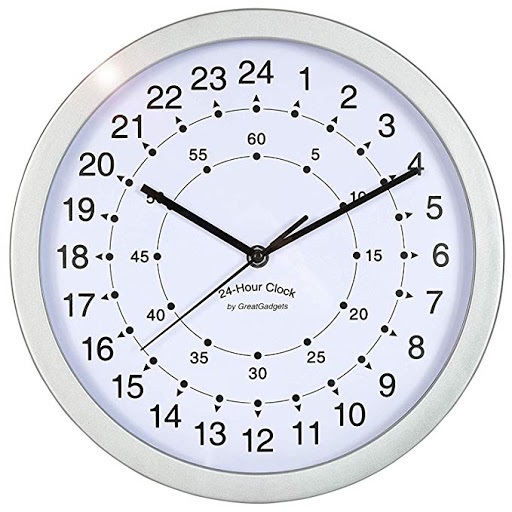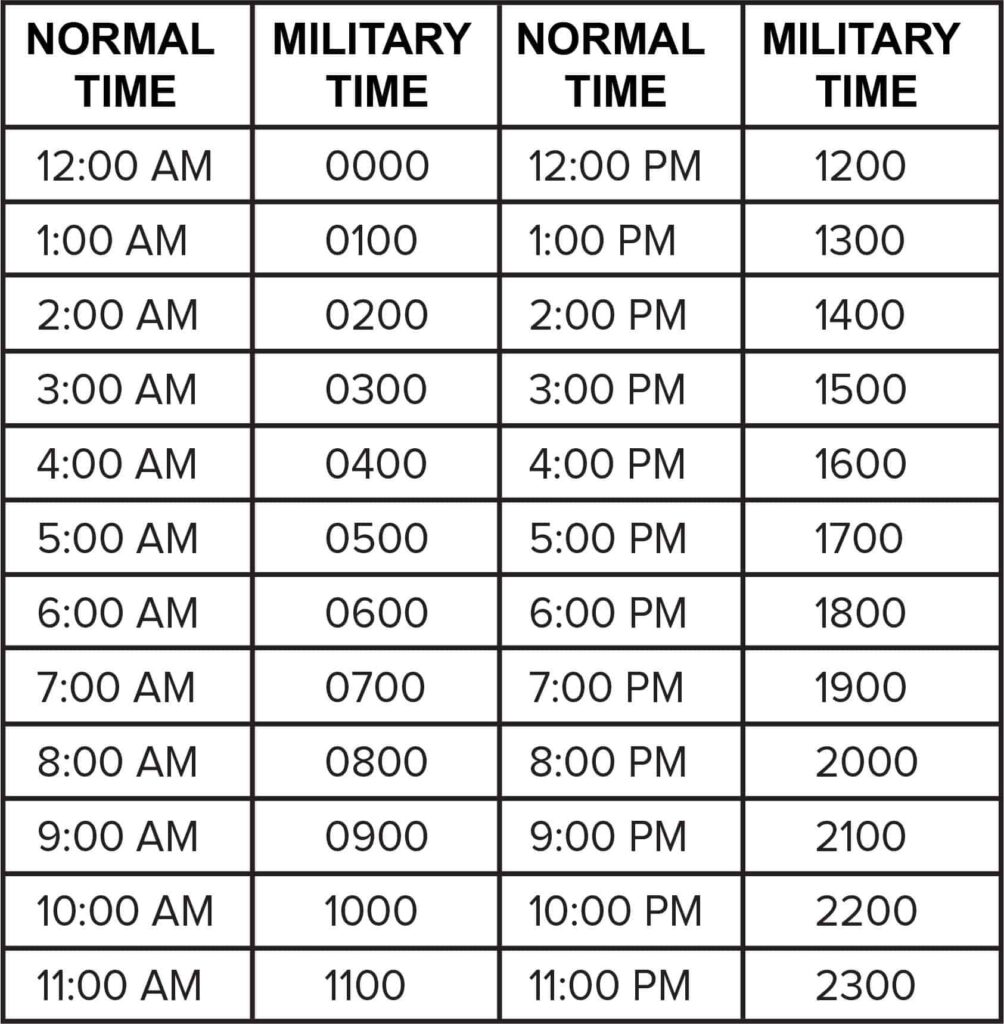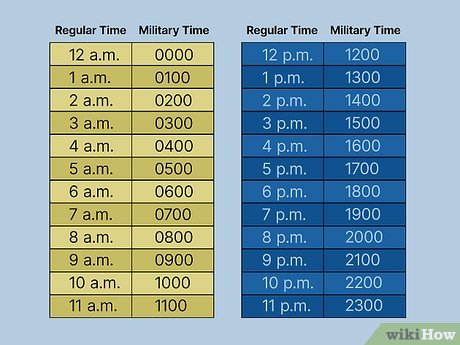Military time, also known as the 24-hour clock, is a timekeeping system widely used in various fields, including military, healthcare, transportation, and international communication.
1630 military time is equivalent to 4:30 PM in standard time, representing the time of 4:30 in the afternoon.
This article will delve into the specifics of 1630 military time, how to understand and convert it, its common uses, advantages, practical applications, tips for remembering it, and frequently asked questions.
Understanding 1630 Military Time:
In military time, each hour of the day is represented by a four-digit number, with the first two digits indicating the hour and the last two digits indicating the minutes.
For instance, 1630 military time refers to 4:30 PM in the standard 12-hour clock system. The number 16 represents 4 o’clock in the afternoon, while 30 indicates 30 minutes past the hour.
How To Convert 1630 Military Time:
- Identify the Hour: In military time, the first two digits represent the hour. For 1630, the hour is 16.
- Adjust for PM: Since military time uses a 24-hour clock, any time after noon needs adjustment for standard time. To convert from military to standard time, subtract 12 from the hour. For 16:30 (4:30 PM), subtracting 12 gives us 4.
- Determine the Minutes: The last two digits in military time represent the minutes. For 1630, the minutes are 30.
- Combine: Put the hour and minutes together. So, 1630 military time becomes 4:30 PM in standard time.
Common Uses Of 1630 Military Time:

1. Military Operations And Communication:
In military operations, timing is critical for strategic maneuvers, mission coordination, and synchronization of activities. 1630 military time allows for clear communication and precise timing among troops and command centers.
2. International Travel And Coordination:
When traveling across different time zones, using military time helps avoid confusion and ensures accurate scheduling of flights, trains, and other modes of transportation. 1630 military time provides a standardized reference point for international coordination of meetings or events.
3. Healthcare Industry:
Hospitals and healthcare facilities often use military time for documentation, scheduling appointments, and administering medication. 1630 military time ensures accuracy in recording patient care activities, appointments, and medication administration times.
4. Emergency Services:
Police departments, fire stations, and medical emergency responders rely on military time for quick and efficient communication and response. Dispatch centers use 1630 military time to coordinate emergency calls, dispatch units, and track response times accurately.
5. Logistics And Supply Chain Management:
In transportation, logistics, and supply chain management industries, precise timing is essential for scheduling shipments, coordinating deliveries, and managing inventory. 1630 military time facilitates efficient planning and execution of logistical operations.
6. Event Planning And Coordination:
Event organizers often use military time to schedule and coordinate various aspects of an event, such as setup, timing of activities, and guest arrivals. Using 1630 military time helps avoid confusion and ensures smooth execution of events.
Practical Applications Of 1630 Military Time:

1. Scheduling And Planning Events:
Event organizers utilize 1630 military time to plan and schedule events with precision. Whether it’s a business meeting, conference, or social gathering, using military time ensures clarity and accuracy in timing, minimizing participant confusion.
2. Transport And Logistics Coordination:
In the transportation and logistics industry, 1630 military time is crucial in scheduling deliveries, coordinating shipments, and managing logistics operations. Logistics companies rely on military time to synchronize the movement of goods efficiently.
3. Emergency Services Response:
Police departments, fire stations, and medical emergency services use 1630 military time to coordinate emergency responses effectively. Dispatchers communicate incident details using military time, enabling first responders to arrive promptly.
4. Shift Scheduling In Industries:
Manufacturing plants, factories, and industrial facilities use military time, including 1630, for shift scheduling and workforce management. Employers use military time to ensure clarity in shift start and end times, minimizing scheduling errors and disruptions.
5. Global Communication:
In multinational corporations and global business operations, 1630 military time is a standardized time format for international communication. Employees across different time zones can easily coordinate meetings and deadlines using military time, eliminating confusion.
6. Healthcare Documentation:
Hospitals and healthcare facilities adopt military time, including 1630, to accurately document medical procedures, patient care activities, and medication administration times. Using military time ensures precision in recording crucial medical information.
7. Navigation And Aviation:
Pilots, air traffic controllers, and navigators rely on military time, such as 1630, for flight planning, air traffic management, and navigation. Military time facilitates clear communication and coordination between aviation professionals, enhancing safety and efficiency in airspace management.
Tips For Remembering Military Time:

1. Associate With Standard Time:
Create associations between military time and standard time. For example, remember that 1630 military time corresponds to 4:30 PM in standard time. Visualizing the standard time alongside military time can help reinforce the connection.
2. Use Mnemonics:
Mnemonics, or memory aids, can be incredibly helpful for remembering military time. Create memorable phrases or rhymes that relate to specific times. For example, during 1630 military time, you could use the mnemonic phrase “Sixteen thirty, time to be flirty.”
3. Practice Regularly:
Like any skill, practice makes perfect. Incorporate military time into your daily routine by setting clocks and watches to military time or challenging yourself to read the time in military format whenever possible. The more you practice, the more familiar you’ll become with military time.
4. Break It Down:
Break down military time into its components – the hour and the minutes. Focus on remembering the hour first, then the minutes. For example, for 1630 military time, remember that 16 represents 4 o’clock in the afternoon, and 30 represents 30 minutes past the hour.
5. Create Visual Aids:
Visual aids, such as flashcards or charts, can help learn and remember military time. Create flashcards with military time on one side and its corresponding standard time on the other. Review these regularly to reinforce your memory.
6. Use Technology:
Take advantage of technology to assist you in learning military time. Use smartphone apps or online resources that provide practice exercises, quizzes, or interactive tools for converting between military and standard time.
7. Apply It In Context:
Apply military time in real-life situations whenever possible. Use it when scheduling appointments, setting alarms, or planning events. The more you use military time in practical contexts, the more comfortable you’ll become with it.
Related Questions:
1. What Is The Significance Of 1630 Military Time?
1630 military time corresponds to 4:30 PM in standard time, serving as a precise indication of time in the afternoon.
2. How Do I Convert 1630 Military Time To Standard Time?
To convert 1630 military time to standard time, subtract 12 from the hour if it’s greater than 12.
3. Why Is Military Time Used?
Military time is used for its clarity, precision, and universal applicability in various fields.
4. Is Military Time Used Worldwide?
Yes, military time is commonly used worldwide in different industries and sectors.
5. How Can I Quickly Learn To Read Military Time?
Practice regularly and use mnemonic devices to associate military time with standard time.
6. Is there an easier way to convert Military Time to standard time?
Yes, another method to convert Military Time to standard time is to subtract 12 from the hour if it’s greater than 12. So, for 1630 Military Time, subtract 12 from 16 to get 4, then add “PM” to indicate afternoon or evening, resulting in 4:30 PM.
7. How can I quickly learn to read Military Time?
Understanding Military Time is relatively straightforward. The hours run from 0000 (midnight) to 2359 (11:59 PM), with the first two digits representing the hour and the last two representing the minutes. If the hour is greater than 1200, subtract 1200 to convert to standard time. Practice and familiarity will make reading Military Time second nature.
Conclusion:
In conclusion, 1630 military time, like other iterations of the 24-hour clock system, plays a vital role in modern timekeeping and communication. Its precision, clarity, and universal applicability make it indispensable in various industries and contexts. Individuals can navigate time more efficiently and effectively by understanding its significance, mastering its conversion, and embracing its practicality.
Read:
